The Palawan Hornbill, an iconic resident of the Palawan region in the Philippines, captivates admirers with its striking appearance and vital ecological role.
With its dark plumage and distinctive white beak topped by a prominent casque, this bird stands out as a symbol of local biodiversity.
Beyond its aesthetic allure, the Palawan Hornbill is a crucial seed disperser, contributing to forest regeneration and ecosystem health.
However, the species faces looming threats from deforestation and hunting, echoing the plight of numerous unique species worldwide.
This introduction underscores the urgent need for conservation efforts to safeguard the Palawan Hornbill and preserve the extraordinary biological diversity of our planet.
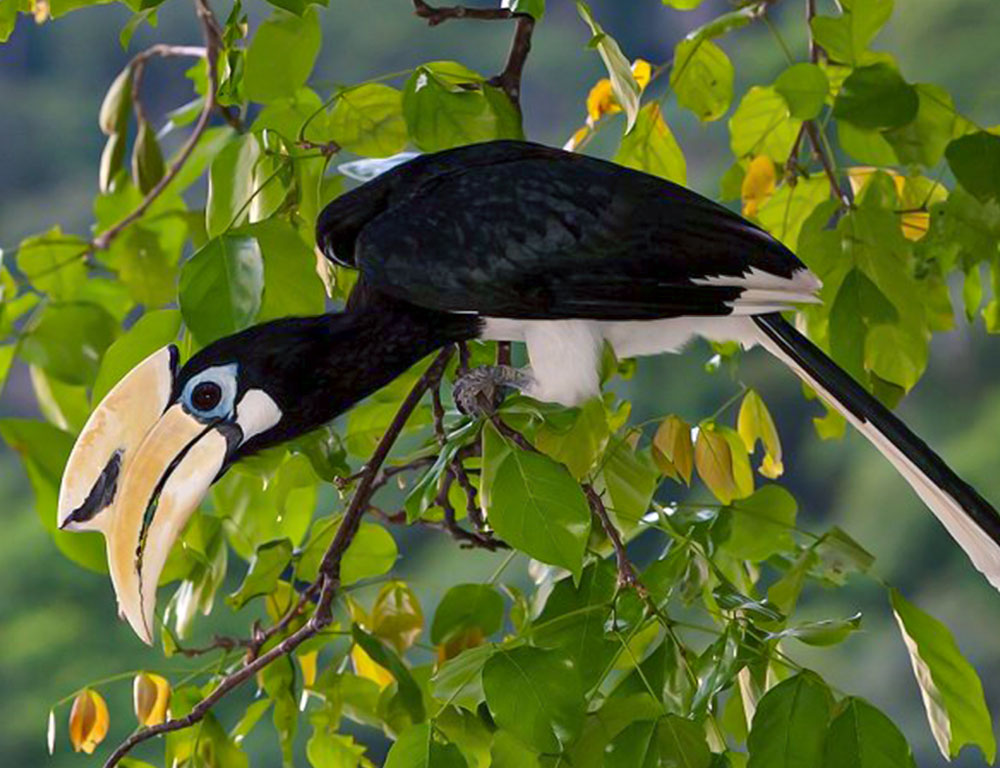
Physical Characteristics of the Palawan Hornbill
The Palawan Hornbill (Anthracoceros marchei) possesses several distinctive physical characteristics that make it a unique and captivating bird species.
Here’s an overview of its physical traits:
Size and Shape
Palawan Hornbills are relatively large birds, with adults typically reaching a height of around 70 centimeters (approximately 27.5 inches).
They have a stout build with broad wings, allowing them to glide gracefully through the air. Their wingspan can be impressive, aiding in their flight.
Bill and Casque
One of the most notable features of the Palawan Hornbill is its large, down-curved bill. This bill is yellowish and is adorned with a prominent casque, a hollow structure that sits atop the bill.
The casque is often shaped like a pointed helmet, earning them the nickname “Helmeted Hornbills.”
Plumage
A striking contrast of black and white feathers characterizes the plumage of the Palawan Hornbill. Most parts of their body, including the head, back, and wings, are covered in pitch-black feathers, giving them an imposing appearance.
Their tail feathers are predominantly white, forming beautiful bands when opened fully during flight or courtship rituals. Additionally, their underparts showcase patches of white feathers, balancing out the overall color scheme.
Eyes
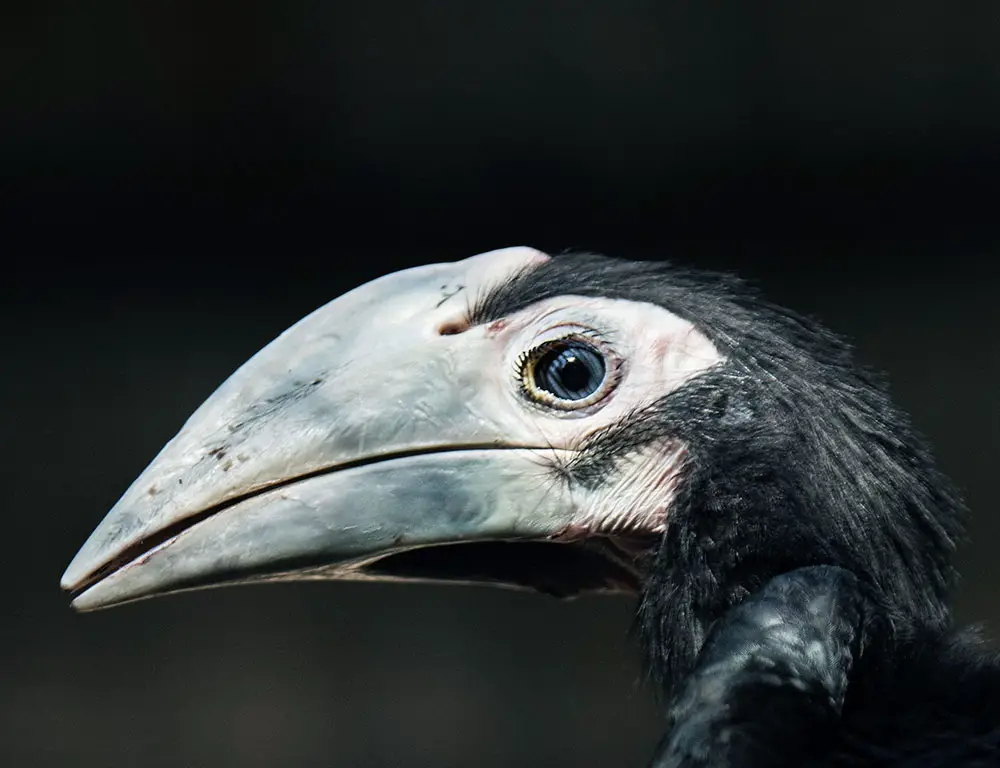
Their eyes are rimmed with bright blue skin, adding another splash of color to their vibrant appearance.
Habitat and Distribution of the Palawan Hornbill
The Palawan Hornbill (Anthracoceros marchei) is an endemic bird species found in the Palawan island group in the western part of the Philippines.
Here’s an overview of its habitat and distribution:
Habitat
Palawan Hornbills primarily inhabit various forest ecosystems within the Palawan island group. These habitats include lowland rainforests, tropical evergreen forests, mangrove forests, and secondary forests.
They prefer areas with dense vegetation, tall trees, and abundant fruit-bearing trees, which provide them with suitable nesting sites and food sources.
Altitude Range
While mainly found in lowland forests, Palawan Hornbills have been observed at up to 1,400 meters (4,600 feet) above sea level. This wide altitude range allows them to inhabit various elevations within their island range.
Geographic Distribution
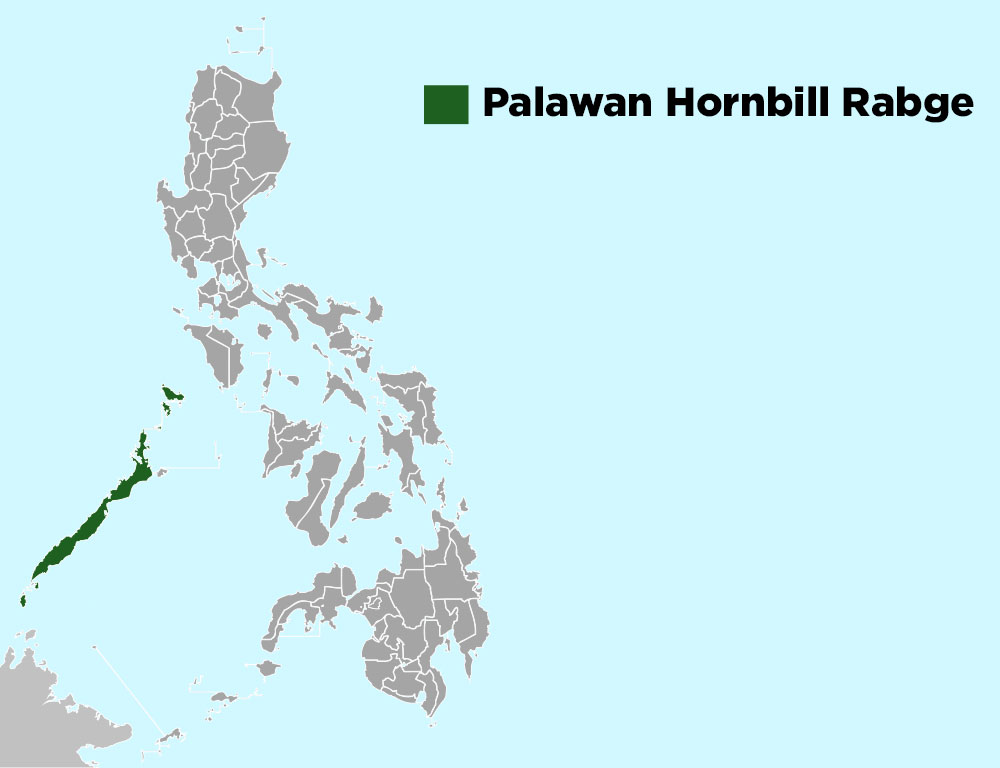
Palawan Hornbills are primarily distributed throughout the Palawan island group, which consists of the main island of Palawan and numerous smaller surrounding islands.
They are most commonly found on the main island of Palawan, but they also occur on nearby islands such as Busuanga, Calauit, and Dumaran.
Microhabitat Preferences
Palawan Hornbills prefer areas with tall trees for nesting and roosting within their forest habitats. They are often found near water sources such as rivers, streams, and freshwater marshes.
Additionally, they may inhabit forest edges, clearings, and disturbed areas adjacent to primary forests.
Behavior of the Palawan Hornbill
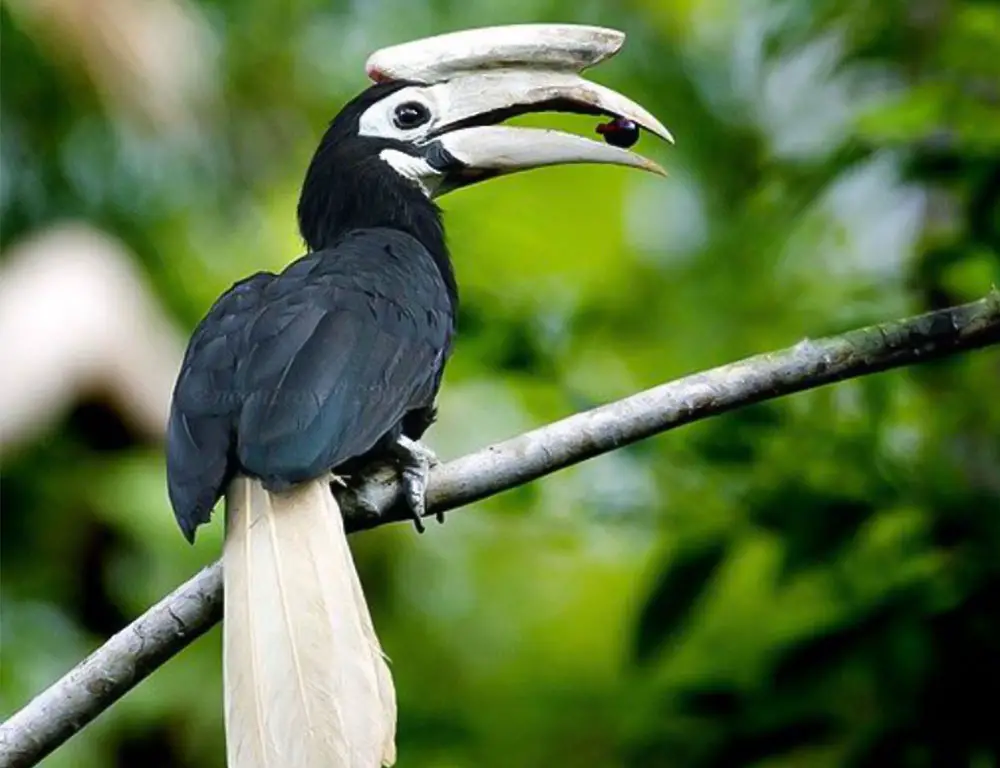
The behavior of the Palawan Hornbill (Anthracoceros marchei) is both fascinating and integral to its survival in its natural habitat. Here are some critical aspects of their behavior:
Diet
Palawan Hornbills are omnivorous birds with a varied diet. They primarily feed on fruits, including figs and other types of fruit found in their forest habitat. Their long, curved bills are well-suited for reaching and consuming tree fruits.
They also consume insects, reptiles, and occasionally small animals like birds. Palawan Hornbills play a crucial role in forest regeneration and ecosystem health by feeding on fruits and dispersing seeds through their droppings.
Breeding
Breeding behavior among Palawan Hornbills is notable for its unique nesting habits. The female hornbill typically lays up to two eggs in a tree hole, which is then sealed off with mud except for a tiny slit.
This sealed nesting site protects the eggs and chicks against predators. During the incubation period, which lasts several weeks, the female remains inside the nest, relying on the male to bring her food.
The male hornbill diligently provides food for both the female and the chicks until they are ready to leave the nest.
Social Behavior
Palawan Hornbills are generally observed in pairs or small family groups. They are known to engage in social behaviors such as cooperative breeding, where family members assist in caring for the young.
Male hornbills play an active role in feeding and caring for the female and chicks during the breeding season.
Vocalizations
Like many bird species, Palawan Hornbills communicate through vocalizations. Their calls include various squawks, honks, and cackles, which communicate with other hornbills in their territory, establish dominance, and coordinate activities within their family group.
Flight
Palawan Hornbills are skilled flyers, using their broad wings to glide gracefully through the forest canopy. They undertake short flights between trees for food and suitable nesting sites.
Conservation Status of the Palawan Hornbill
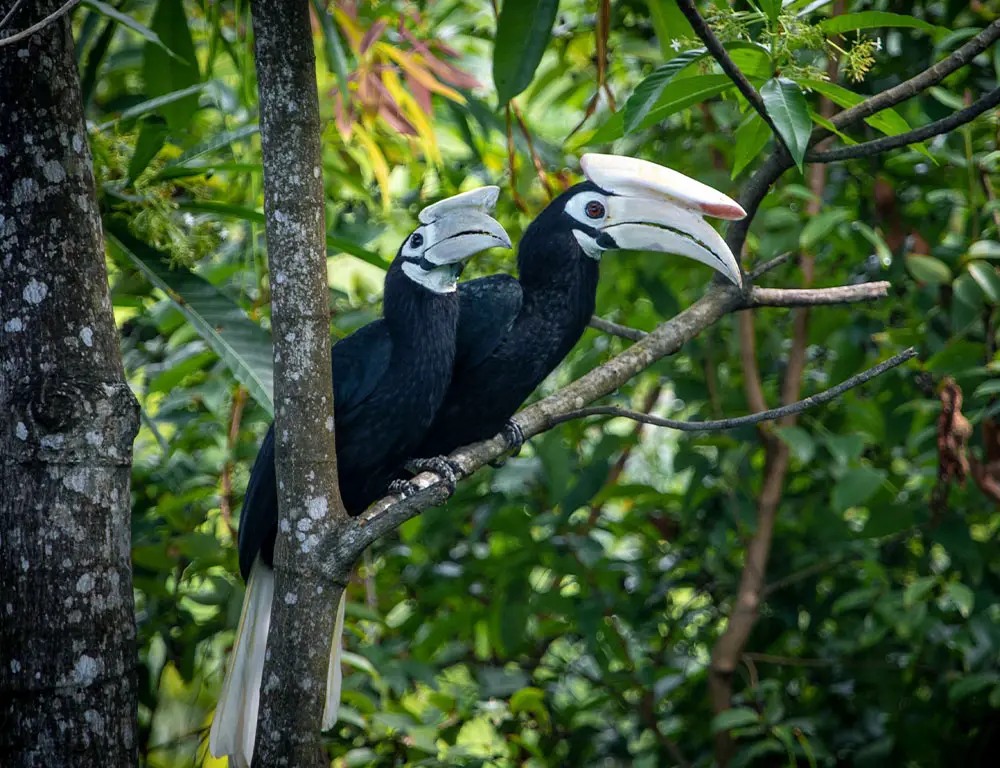
The conservation status of the Palawan Hornbill (Anthracoceros marchei) is classified as “Vulnerable” on the International Union for Conservation of Nature (IUCN) Red List.
This designation indicates that the species faces a high risk of extinction in the wild if the threats to its survival are not effectively addressed.
Here’s a detailed overview of its conservation status:
Threats
- Habitat Loss: Extensive deforestation in the Palawan island group, primarily driven by logging, agricultural expansion, and infrastructure development, is a significant threat to the Palawan Hornbill’s habitat. Loss of forest cover reduces nesting sites, roosting areas, and food sources for the species.
- Illegal Wildlife Trade: Palawan Hornbills are targeted for illicit trade due to their distinctive appearance and the demand for their casques and other body parts in traditional medicine and the illegal wildlife market. Poaching for the pet trade also contributes to population declines.
- Hunting and Capture: While hunting for food and capture for the pet trade are considered lesser threats than habitat loss and illegal trade, they still impact hornbill populations, particularly in local communities.
Conservation Efforts
- Legal Protection: The Palawan Hornbill is protected under national and international legislation, including the Philippines’ Wildlife Resources Conservation and Protection Act.
This legislation prohibits hunting, capturing, and trading of the species, providing legal protection for its conservation. - Habitat Conservation: Conservation organizations and government agencies are involved in efforts to protect and restore the habitat of the Palawan Hornbill.
These initiatives include establishing protected areas, implementing sustainable forest management practices, and restoring degraded habitats. - Community Engagement: Education and awareness programs are conducted to engage local communities in conservation efforts.
These programs aim to raise awareness about the importance of hornbills for biodiversity and ecosystem health, promote sustainable livelihoods, and reduce human-wildlife conflicts. - Research and Monitoring: Ongoing research and monitoring projects are conducted to assess the status of Palawan Hornbill populations, identify critical threats, and inform conservation strategies. This includes population surveys, ecological studies, and genetic research.
FAQs
How does the Palawan Hornbill contribute to its ecosystem beyond seed dispersal?
In addition to seed dispersal, the Palawan Hornbill controls insect populations, helping maintain ecological balance within its habitat.
What is the average lifespan of a Palawan Hornbill in the wild?
The average lifespan of a Palawan Hornbill in the wild is estimated to be around 20 to 30 years. However, this can vary depending on factors such as predation, disease, and habitat conditions.
Are Palawan Hornbills considered social birds?
Yes, Palawan Hornbills exhibit social behavior, often forming pairs or small family groups. They may engage in cooperative breeding, where family members assist in caring for the young.
How do Palawan Hornbills communicate with each other?
Palawan Hornbills communicate through various vocalizations, including squawks, honks, and cackles. These vocalizations communicate with other hornbills, establish territory, and coordinate activities within their family groups.
Are there any cultural or symbolic associations with the Palawan Hornbill?
Yes, the Palawan Hornbill holds cultural significance in the Philippines, where it is often depicted in traditional art and folklore. It is also considered a symbol of biodiversity and natural heritage in the Palawan region.
Conclusion
Exploring the captivating world of the Palawan Hornbill has illuminated its vital role in the delicate ecosystem of Palawan. As diligent seed dispersers, these birds are ornamental wonders and essential agents of forest regeneration.
However, their precarious status as “Vulnerable” on the IUCN Red List underscores the urgent need for conservation action.
We must rally behind these remarkable creatures, whose habitat loss and hunting threaten their existence.
As stewards of nature, we must strive to protect the Palawan Hornbill and its habitat, ensuring that future generations can continue to marvel at their beauty and appreciate their significance in maintaining the ecological balance.
Let’s unite to preserve these majestic birds, safeguard biodiversity, and nurture our planet’s rich tapestry of life.